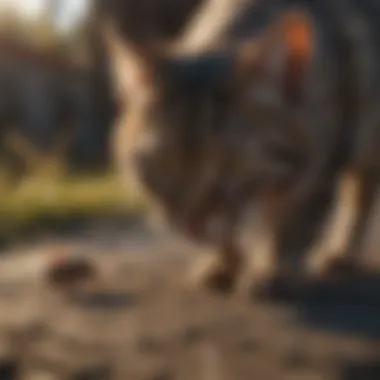Proven Methods for Successfully Eliminating Rats from Your Environment


Preventive Pest Control Strategies
In the realm of pest control, taking proactive measures is key to maintaining a pest-free environment within your home. One of the fundamental strategies in preventing pest infestations is focusing on safeguarding the exterior of your house. Simple yet effective tips such as sealing cracks in walls and foundations can significantly impede pests such as rats from finding their way indoors. Moreover, clearing debris in your yard not only enhances the aesthetic appeal of your outdoor space but also eliminates potential hiding spots for pests. To further bolster your defense against pests, implementing methods to deter them from entering in the first place is crucial. This can include using barriers such as mesh screens on windows and vents to block their access points.
When it comes to yard maintenance, adhering to essential routines can contribute to a pest-free outdoor area. Regularly mowing the lawn, trimming shrubs, and removing any standing water helps mitigate environments that attract pests. Additionally, employing techniques like companion planting or using non-toxic pest repellents can serve as natural deterrents to safeguard your yard from unwanted critters.
Maintaining indoor cleanliness is paramount in preventing pest infestations. Expert cleaning tips like decluttering regularly, sealing food containers, and ensuring proper waste management can go a long way in creating a pest-resistant indoor environment. Proper garbage disposal practices are integral in deterring pests as well; disposing of trash promptly and securely can deter rats and other pests from being drawn to your property. Embracing innovative strategies beyond traditional pest control methods offers a proactive approach to safeguarding your home from potential infestations.
Understanding Rat Behavior
Rat behavior plays a pivotal role in effectively eradicating these pests from your surroundings. By understanding the behavior patterns of rats, individuals can implement targeted extermination strategies to safeguard their environments. This section delves into the nuances of rat behavior, shedding light on their physical attributes, feeding habits, and common sheltering areas.
Rat Behavior Patterns
Physical Attributes of Rats
Physical attributes of rats encompass their size, color, and agility, crucial factors in identifying and combatting infestations. Rats are known for their compact bodies, fur-covered tails, and sharp teeth, allowing them to navigate through small spaces with ease. Their adeptness at climbing and digging further complicates eradication efforts. While these attributes make rats formidable pests, understanding them aids in devising effective extermination methods tailored to their capabilities.
Feeding Habits of Rats
Rats are opportunistic feeders with a preference for grains, fruits, and human scraps. Their omnivorous diet and ability to consume large quantities pose challenges in controlling their populations. By recognizing their feeding patterns, individuals can deploy baits and traps strategically, enticing rats while minimizing non-target exposure. Knowledge of rats' dietary preferences is instrumental in curbing infestations and preventing reoccurrences.
Common Sheltering Areas for Rats
Rats seek shelter in dark, secluded spaces close to reliable food sources, making attics, basements, and wall voids ideal habitats. Understanding these preferences aids in pinpointing potential infestation sites and crafting preventive measures. By addressing and fortifying these areas, individuals can disrupt rats' living conditions, discouraging them from establishing territories. Awareness of common sheltering areas empowers individuals to proactively defend their properties against infestations.
Preventive Measures
In the battle against rat infestations, preventive measures play a crucial role in ensuring long-term success. By implementing strategic preventive tactics, homeowners can create an inhospitable environment for rats, minimizing the risk of infestation. These preventive measures not only address existing vulnerabilities but also act as a proactive approach to rat control. Understanding the significance of preventive measures is paramount in the effective eradication of rats from your property.
Sealing Entry Points


Identifying Access Points
Identifying access points is a fundamental step in rat control. By meticulously locating and sealing entry points, homeowners can prevent rats from infiltrating their homes. Access points commonly include gaps in walls, cracks in foundations, and openings around pipes. The key characteristic of identifying access points lies in its ability to target the root cause of infestation, cutting off rats' entryways at the source. By addressing these vulnerabilities, homeowners can significantly reduce the likelihood of rat incursions, safeguarding their properties effectively.
Using Sealants to Block Entry
Utilizing sealants to block entry points reinforces the effectiveness of rat control strategies. Sealants provide a durable barrier against potential access points, ensuring that rats are denied entry into homes. The unique feature of using sealants lies in their versatility and durability, offering long-lasting protection against rat intrusions. While sealants serve as a beneficial choice for rat extermination, it is essential to consider their application carefully to maximize efficacy and longevity in preventing rat infestations.
Reinforcing Weak Structural Points
Reinforcing weak structural points enhances the integrity of a property, minimizing the risk of rat infestation. Weak structural points such as loose vent covers or damaged doors/windows can serve as entry points for rats. Strengthening these weak links fortifies the property's defenses against rodents, creating an inhospitable environment for infestation. The advantages of reinforcing weak structural points include long-term protection and peace of mind, knowing that the property is fortified against rat intrusions. While reinforcing weak structural points requires initial investment, the benefits far outweigh the costs, ensuring a rat-free environment for homeowners.
Maintaining Cleanliness
Maintaining cleanliness is a foundational aspect of rat control, as it deprives rats of food sources and shelter. Proper waste disposal is essential in eliminating attractants for rats, as overflowing garbage bins can lure these pests into homes. Regular cleaning practices, such as sanitizing surfaces and decluttering, further reduce potential hiding spots for rats, minimizing their ability to thrive. The unique feature of cleanliness maintenance lies in its proactive nature, preventing rat infestations before they occur. While maintaining cleanliness requires consistent effort, the benefits of a rat-free environment and improved hygiene make it a worthwhile investment for homeowners.
Regular Cleaning Practices
Regular cleaning practices, including vacuuming, dusting, and disinfecting, are essential in deterring rat infestations. By removing food residue and debris, homeowners disrupt rats' food sources, forcing them to seek sustenance elsewhere. The key characteristic of regular cleaning practices is their impact on rat behavior, making homes less appealing to these pests. While time-consuming, regular cleaning routines contribute significantly to rat control, ensuring a hygienic and pest-free living environment for residents.
Reducing Clutter
Reducing clutter minimizes potential hiding spots for rats, limiting their ability to establish nests and breed. Cluttered spaces provide ideal conditions for rats to thrive, offering ample hiding places and nesting materials. By decluttering living spaces and storage areas, homeowners eliminate attractive environments for rats, discouraging infestations. The advantages of reducing clutter include improved accessibility for monitoring and cleaning, making it easier to detect and address early signs of rat activity. While decluttering requires organizational effort, the long-term benefits of a clutter-free home outweigh the initial challenges, promoting a rat-free living space for occupants.
Effective Extermination Methods
When it comes to dealing with a rat infestation, the effectiveness of your extermination methods is paramount. In this crucial section of the article, we delve into various approaches that can help you combat the nuisance of rats effectively. By choosing the right tactics, you can ensure the comprehensive removal of these pests from your surroundings, safeguarding your property and ensuring a healthy living environment. By understanding and implementing the techniques outlined in this section, you can achieve long-lasting results in the battle against rat infestations.
Traps and Baits
Types of Rat Traps


Types of rat traps play a significant role in the success of your extermination efforts. Snap traps, electronic traps, and live-catch traps are popular choices, each with its unique advantages and functions. Snap traps offer swift elimination, electronic traps provide efficiency, and live-catch traps offer a humane approach to catching rats. Understanding the key characteristics of each trap type enables you to select the most suitable one for your specific needs, ultimately contributing to a successful rat removal process.
Choosing Suitable Baits
Selecting suitable baits is a crucial decision in rat extermination. Peanut butter, cheese, and nuts are commonly used baits due to their strong smell and appeal to rats. By choosing baits that attract rodents effectively, you increase the likelihood of trapping them successfully. Considering the preferences and dietary habits of rats can help you tailor your bait choices for optimal results in trapping these pests.
Strategic Placement of Traps
Where you place your traps can greatly impact their effectiveness. Placing traps along common rat pathways, near nesting areas, and along walls can increase the chances of rat capture. By strategically positioning traps in areas frequented by rats, you enhance the likelihood of trapping them and minimizing their presence in your property. Thoughtful trap placement is key to a successful rat extermination strategy.
Natural Deterrents
Peppermint Oil
Peppermint oil is known for its strong scent that repels rodents. Its natural properties make it a popular choice for deterring rats without the use of harmful chemicals. By utilizing peppermint oil strategically in areas prone to infestation, you can create a barrier that discourages rats from entering your space. Additionally, its eco-friendly nature makes it an environmentally conscious option for rat control.
Citrus Peels
The citric scent of citrus peels has been found to deter rats due to its overpowering aroma. Utilizing citrus peels as a natural repellent can help discourage rats from entering your property. They are easy to use, cost-effective, and environmentally friendly, making them a preferred choice for those seeking natural rat deterrents.
Predator Urine
Predator urine, such as that of foxes or big cats, mimics the presence of natural predators to rodents. This natural deterrent triggers the prey instinct in rats, causing them to avoid areas where predator urine is detected. By strategically placing predator urine in locations vulnerable to infestation, you can create a hostile environment for rats, encouraging them to stay away from your property.
Professional Pest Control Services
Hiring Certified Exterminators
Professional pest control services offer expertise in handling rat infestations. Certified exterminators possess the knowledge and tools to effectively eliminate rats from your property while adhering to safety protocols. By entrusting the task to professionals, you can ensure a thorough and efficient extermination process, minimizing the risk of recurring infestations.
Integrated Pest Management


Integrated Pest Management (IPM) combines various strategies to manage pests effectively. By incorporating preventive measures, monitoring techniques, and targeted interventions, IPM offers a comprehensive approach to pest control. This holistic method not only addresses current infestations but also focuses on long-term prevention, promoting sustainable pest management practices.
Sustainable Pest Control Practices
Sustainable pest control practices prioritize environmentally friendly solutions for pest management. By opting for eco-friendly pest control methods, you can reduce the environmental impact of extermination processes. From utilizing natural repellents to implementing non-toxic treatments, sustainable practices ensure the well-being of both the ecosystem and your property, fostering a harmonious coexistence with nature.
Monitoring and Maintenance
Monitoring and maintenance play a pivotal role in the effective management of rat infestations. In this article, the emphasis on monitoring and regular inspection is key to ensuring the success of rat extermination efforts. It is vital to have a proactive approach to detect and address any signs of infestation promptly. By engaging in consistent monitoring and maintenance practices, homeowners can prevent significant rat-related damage to their property and potential health risks.
Regular Inspections
Checking Traps and Baits
Checking traps and baits is a crucial aspect of rat extermination. This step involves inspecting traps for captured rats and replacing baits to maintain their effectiveness. By regularly checking traps and baits, homeowners can assess the success of their trapping methods and make necessary adjustments. The key characteristic of this process is its ability to provide real-time feedback on the rat population and the effectiveness of the chosen trapping techniques. It is a popular choice for this article because it allows for targeted and strategic rat removal, minimizing the risk of contaminants or property damage. One unique feature of checking traps and baits is its non-toxic nature, making it a safe and humane approach to pest control. While it offers several advantages, such as minimizing rat populations efficiently, some disadvantages include the need for ongoing vigilance and maintenance to ensure continued efficacy in trapping rats.
Assessing Property Vulnerabilities
Assessing property vulnerabilities is essential for identifying potential entry points or weak spots where rats can access the property. By conducting a comprehensive assessment, homeowners can proactively strengthen structural points and seal off access areas to prevent rat entry. The key characteristic of this practice is its focus on proactive rat prevention by addressing vulnerabilities before infestations occur. It is a popular choice for this article as it aligns with proactive pest control measures to limit rat intrusion. One unique feature of assessing property vulnerabilities is its ability to tailor prevention strategies to specific property needs, enhancing overall effectiveness. While it offers advantages such as reducing the risk of future infestations, some disadvantages include the time and effort required to conduct thorough property assessments.
Addressing New Signs of Infestation
Addressing new signs of infestation is critical to maintaining a rat-free environment. This step involves promptly investigating and addressing any newfound indicators of rat activity, such as fresh droppings or gnaw marks. By taking immediate action, homeowners can prevent infestations from escalating and causing extensive damage. The key characteristic of this practice is its responsiveness to emerging rat activity, allowing for swift intervention to contain and eliminate potential infestations. It is a beneficial choice for this article as it emphasizes the importance of proactive pest management strategies. One unique feature of addressing new signs of infestation is its ability to target specific areas of concern, enabling focused efforts on rat control. While advantages include early detection and minimization of infestation consequences, some disadvantages include the need for consistent monitoring and quick intervention to prevent rat spread.
Sustainable Practices
Environmental Impact Consideration
Environmental impact consideration is a crucial aspect of rat extermination that focuses on implementing eco-friendly and non-toxic pest control solutions. By taking into account the environmental repercussions of pest control methods, homeowners can minimize harm to surrounding ecosystems and non-targeted species. The key characteristic of this practice is its eco-conscious approach, which aligns with sustainable and responsible pest management practices. It is a popular choice for this article due to its emphasis on minimizing ecological harm while effectively eliminating rats. One unique feature of environmental impact consideration is its use of natural deterrents and eco-friendly products, promoting a safe and eco-conscious pest control approach. While advantages include protecting the environment and wildlife, some disadvantages may involve the potential limitations of certain eco-friendly pest control methods.
Long-Term Prevention Strategies
Long-term prevention strategies focus on implementing measures that deter future rat infestations and safeguard properties in the long run. By incorporating preventive tactics into their pest control routine, homeowners can significantly reduce the likelihood of recurrent rat issues. The key characteristic of this strategy is its proactive nature, aiming to create a hostile environment for rats and prevent future infestations effectively. It is a beneficial choice for this article as it reinforces the importance of ongoing pest management to maintain a rat-free environment. One unique feature of long-term prevention strategies is their ability to provide sustainable protection against rats without relying solely on temporary solutions. While advantages include sustained pest control efficacy over time, some disadvantages may involve the initial investment required for long-term prevention mechanisms.
Community Involvement in Pest Management
Community involvement in pest management advocates for collaborative efforts among homeowners, neighborhoods, and local authorities to address rat infestations collectively. By fostering community engagement and knowledge-sharing, individuals can work together to tackle widespread pest issues and promote a cleaner and safer environment for all. The key characteristic of this practice is its communal approach, emphasizing the power of collective action in combating rat problems on a larger scale. It is a popular choice for this article as it underscores the importance of community responsibility in pest control and maintenance. One unique feature of community involvement in pest management is its potential to leverage shared resources and expertise for more effective rat extermination campaigns. While advantages include enhanced community awareness and support for pest control initiatives, some disadvantages may relate to coordination challenges and varying community priorities in pest management efforts.



